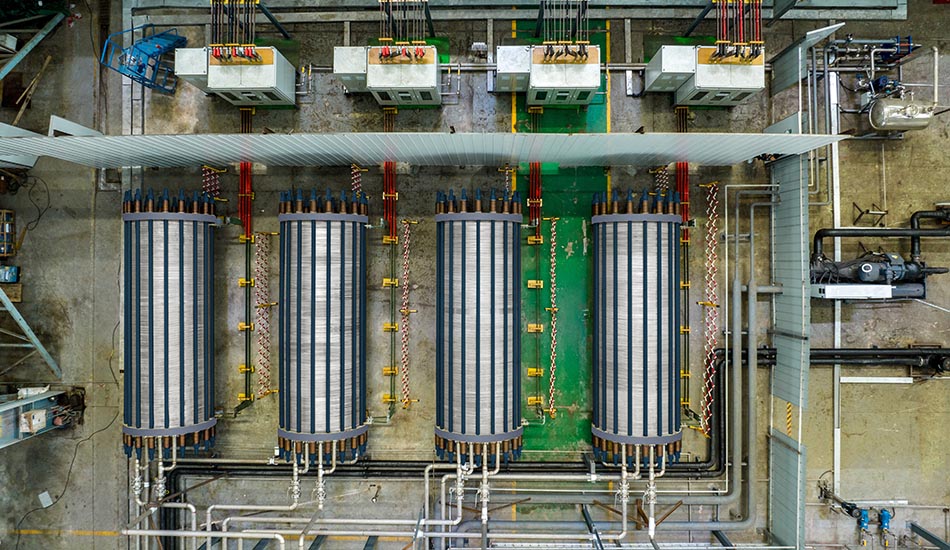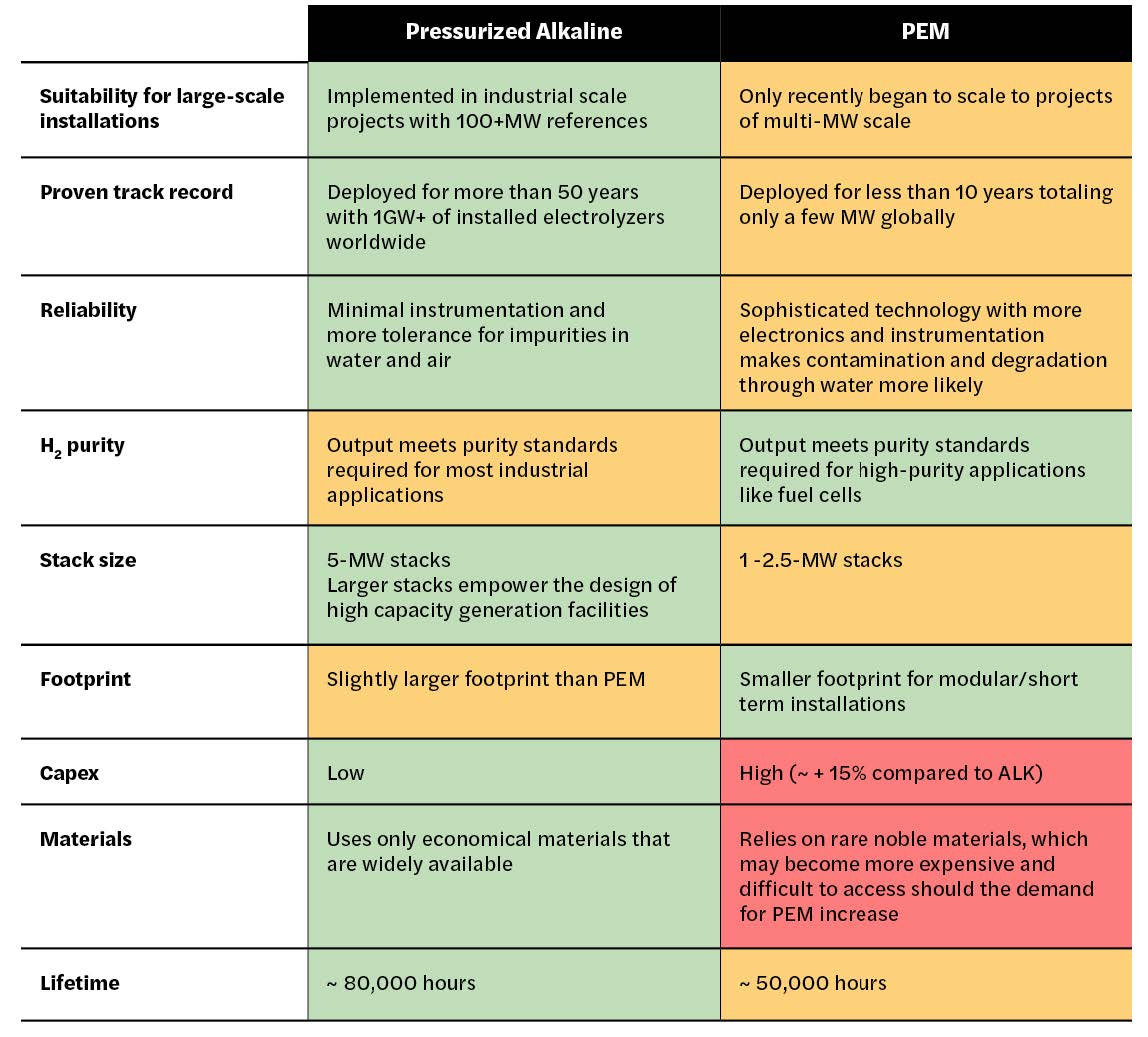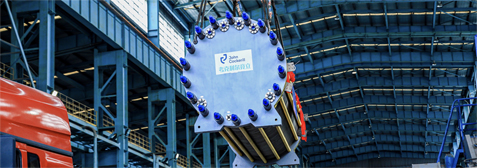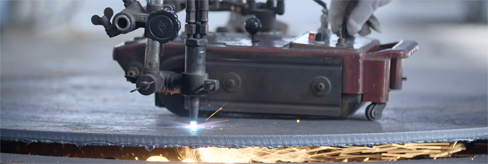In the rapidly evolving landscape of renewable energy, hydrogen is playing a pivotal role in the quest for sustainable solutions. And to produce green hydrogen, electrolyzers are integral—with alkaline and proton exchange membrane (PEM) electrolyzers standing out as especially prominent technologies. As more industries embrace the potential of hydrogen as a clean energy carrier, understanding the nuances between different electrolyzers becomes imperative for stakeholders navigating the path toward a hydrogen-powered future. So between these options, which is the right choice for your specific application, accounting for their distinct features, capabilities, and efficiency levels?
Understanding the available types of electrolyzers
Today, green hydrogen is typically produced using one of four technologies: alkaline, PEM, solidoxide, and anion exchange membrane (AEM). Of these, solid-oxide and AEM are the most recently developed, with little track record in the market. While they both show promise when it comes to efficiency and productivity, they’re still being tested, and we expect it to take another 5-7 years before the technology is proven for large projects.
That leaves us with alkaline and PEM electrolyzers—the two major technologies deployed most widely around the world for hydrogen production. Alkaline electrolyzers are the most common technology on the market today and are likely to remain so in the coming years, representing between 70-90% of annual electrolyzer shipments worldwide*. However, interest in PEM electrolyzers is growing, with some companies wondering which—PEM or alkaline electrolyzers—is the better choice for their installation.
*Source: Bloomberg NEF, 2H 2023 Hydrogen electrolyzer market outlook

Alkaline and pressurized alkaline electrolyzers: Robust technology for a range of applications
Within the realm of electrolyzers, alkaline is the most established and mature technology. It’s been in use for decades—including in 100+MW industrial projects—, showing performance and durability and its deep history means that it is generally easier to monitor, maintain, and operate. It offers the lowest capex due to the use of more economical materials and the deployment of larger stacks, enabling economies of scale. Its robust technology makes it suitable for any environment, including harsh industrial environments, and it boasts the highest tolerance for raw feed water.
A subsection of alkaline electrolyzers, pressurized alkaline electrolyzers (sometimes referred to as alkaline 2.0 or advanced alkaline) offer these same advantages with the addition of some innovative features that are more suited for today’s needs. Still produced without noble or rare materials, they’ve been redesigned to be operating with more reactivity and dynamism, making them able to follow variable energy requests—common when renewable energy is used for power. They integrate pressurizing capabilities, reducing needs for costly downstream compression and bringing additional advantages including footprint and costs reduction at system level.
While both of these forms of electrolyzers have been in use for many years, the technology is still continuing to evolve over time—introducing incremental improvements in performance, cost efficiency, and operational effectiveness—to stay at the forefront of market needs. New materials and digital developments offer great opportunity for improvements.
PEM electrolyzers: a technology for small-scale installations or high-purity applications transitioning to larger projects
PEM electrolyzers are newer than alkaline, and they were originally designed for transportation projects, which require an optimized footprint, flexibility, and high-purity output. They also offer a higher pressurized output, which is useful when direct liquefaction is required after production.
Because they were created for the needs of a particular industry, they feature sensitive components that can be easily damaged or degraded when deployed in other environments, particularly for industrial applications. Those sensitive components also require the use of rare and noble materials, which are difficult to access and can lead PEM electrolyzers to cost 15-30%* more than alkaline electrolyzers. And finally, while it features newer technology than alkaline electrolyzers do, it lacks field data on long-term degradation and has not yet been proven in large-scale projects. As of now, the largest PEM project in operation is 20 MW.
*Sources: Monitor Deloitte, Bloomberg NEF, IRENA and Bloomberg NEF, Electrolysis System Capex could drop 30% by 2030

Choosing between alkaline and PEM
There is no single electrolyzer technology that performs better across all dimensions, but depending on your use case, one may be better suited for your needs. When choosing between electrolyzers, you will need to consider several factors that are unique to your project: cost of electricity, power supply, pressure output needed, footprint available, size of your project, and operating conditions, among others. As you evaluate your options, you may also want to consider key points such as:
Pressurized alkaline offers benefits over atmospheric: An enhancement to traditional alkaline electrolyzers, pressurized alkaline requires less energy, more easily follows variable renewable energy load, and offers the ability to feed hydrogen directly into an industrial process. In addition, by including pressurization capabilities within the electrolyzer, it reduces or eliminates the need for additional compression, cutting overall costs and avoiding the capex and opex required for a downstream compressor.
A large single stack is better suited for scaling up: Remember that 5-MW stacks are better suited than smaller stacks for large-scale industrial hydrogen production facilities. While PEM offers a smaller footprint, its small stack size makes it suitable for only more specialized instances where there is no need to scale or deploy a large number of electrolyzers.
PEM technology requires costly scarce metals and fluoropolymers: PEM electrolyzers require expensive iridium and platinum metals. These materials contribute to a higher overall cost—and their scarcity could put the availability of PEM electrolyzers as a whole in jeopardy. IRENA estimates that worldwide iridium production is only sufficient for 10-12 GW electrolyzers/year. In addition, PEM electrolyzers require the use of fluoropolymers to separate the electrodes. Fluoropolymers belong to a class of chemicals called per-and polyfluoroalkyl substances (or PFAS). Known as “forever chemicals,” PFAS are extremely persistent in our environment and bodies, where they can lead to health problems such as liver damage, thyroid disease, obesity, fertility issues, and cancer.
That said, there are broad trends to reference when it comes to evaluating electrolyzers. In general, alkaline and pressurized alkaline electrolyzers are the best fit for most applications. They are suited for large-scale installations and can be easily scaled as needs change. They offer greater flexibility, more robust and reliable technology, and output that meets the needs of most industries. Those operating in the transport sector or other more specialized industries may find PEM to be the better choice. It features a smaller footprint and produces output at purity levels that meet exceptionally stringent requirements. For needs in controlled environments where the risk of contamination is minimal and the need for purity is high, PEM can be a good choice.
By dissecting the advantages and limitations of each electrolyzer type, companies can arm themselves with valuable insights to make informed decisions aligned with their specific needs and goals in the world of green hydrogen production. When choosing between alkaline, pressurized alkaline, and PEM electrolyzers, make sure to take a holistic view that accounts for factors such as efficiency, cost, scalability, and suitability for your unique application.
If your organization is exploring the different types of electrolyzers available on the market, you may still feel overwhelmed by the options available to you. For more than 30 years, John Cockerill has advised companies on the deployment of large-scale electrolyzers. For additional information or support, contact us.












